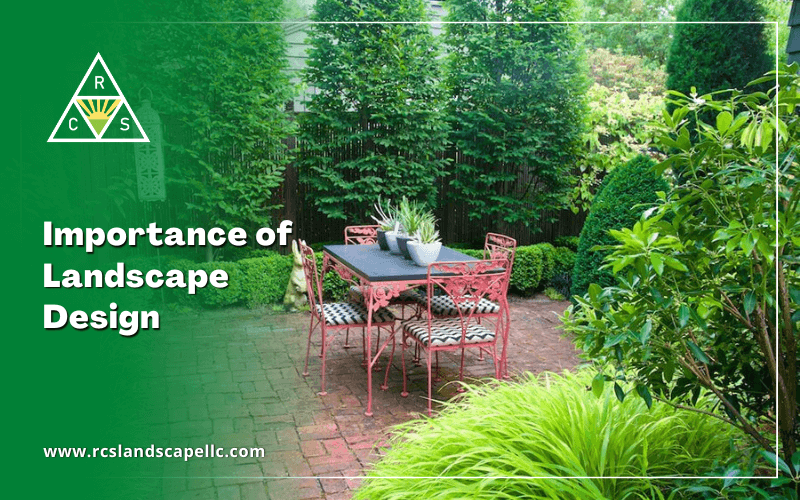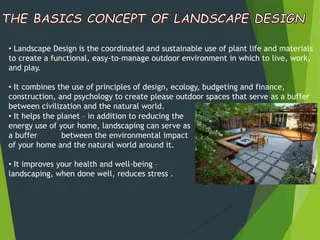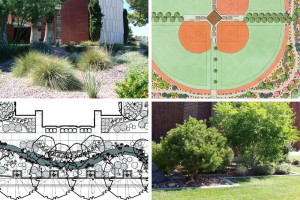Landscape Design Fundamentals Explained
Table of ContentsThe 10-Minute Rule for Landscape DesignNot known Facts About Landscape DesignNot known Details About Landscape Design Some Known Facts About Landscape Design.The Only Guide to Landscape Design
A yard can generally be split into three locations: public (the front yard), private (the back yard), and service (usually the side backyard). The area of task locations depends mostly on the type of location, the dimension of area needed, the kind of activity, and the preferred distance to various other tasks and frameworks.The outside wall surface of the home typically functions as the initial wall or beginning point of an exterior area. Inappropriate uses need to be separated, and associated activities, such as food preparation and dining, ought to be created to make the yard extra reliable and enjoyable. When using hardscape to develop rooms, utilize construction material comparable to that made use of in your house for continuity from your house right into the yard.
Connected spaces. Debt: Gail Hansen, UF/IFAS Making use of comparable hardscape attributes and repeating plants draws the eye around the garden. Crucial points along the road can be highlighted with plantings or features that draw interest and urge movement in a certain instructions. Relocating along the course takes an individual from one area to the next and enables the individual to have a selection of experiences.
Landscape Design Fundamentals Explained

For emotional comfort plants are used as physical or implied barriers for privacy and safety. Physical barriers obstruct both the sight and access to a room and consist of fences, wall surfaces and plant bushes. Implied barriers, typically reduced growing plants, block accessibility but not the sight (Figure 9). Other features of plants include cleansing the air, stopping erosion and dirt loss, preserving moisture in the dirt, and returning raw material to the dirt.
Physical and suggested barriers. Credit Scores: Gail Hansen, UF/IFAS For these reasons, the kinds of plants to be utilized (such as trees, shrubs, or groundcovers) need to be selected in the onset of preparation (Landscape Design). Plant kinds are selected for their functional capacities to make sure that their future function and called for area can be thought about at the exact same time

A Biased View of Landscape Design
Each plant mass is in front of, behind, or following to, an additional mass. Credit History: Gail Hansen, UF/IFAS Repeating plants within a mass and duplicating masses with comparable plants connects the yard with each other. The individual plant qualities must be thought about to effectively layer and mass plants.
All plant compositions start with the major structure plants, the big, mostly evergreen background plants-such as the trees and big hedges. These plants different or enframe spaces, manage the dimension of the area, and provide the starting point for selecting the read review appropriate attributes of the second layer, midground plants, for massing and infill.
Crucial factors in the garden ought to be highlighted by the usage of one-of-a-kind plants, distinct structures, or yard accessories. Noting limits or entrances to rooms can be performed with entrances, arbors, and actions, or via using one-of-a-kind and colorful plants. The form and/or style theme of the garden will often assist establish the essential points and how they should be highlighted.
Various other essential places in the yard are focal factors, which is made use of to aesthetically organize a designed location. Different perspectives or point of views can expose various compositions in the landscape that might need a selection of focal factors.
Landscape Design Things To Know Before You Get This
Number 13. Plant kinds. Credit Scores: Gail Hansen, UF/IFAS After type, texture is the following dominant attribute of a plant; crude, medium and Click Here fine structures can be utilized for comparison and emphasis in the landscape. Form and texture both trump color in the yard for the majority of the year. Throughout certain seasons, shade will be the most noticeable feature of the yard.
The enjoyable scent of plants, the sound of wind in the trees, the sound and appearance of water, and the colors and structures of sculptures, pots and garden furnishings all contribute to the experience of the yard. One information that is frequently ignored is the impact of light on the aesthetic appeals of the plants.

The Basic Principles Of Landscape Design
It is Visit Your URL necessary to know the ultimate fully grown size of plants so they can be put in the right location and spaced properly when they are installed. Giving plants space to expand is an obstacle because the common fully grown dimension is generally based on optimal expanding conditions and the ecological conditions of a site might create a plant to grow larger or stay smaller.